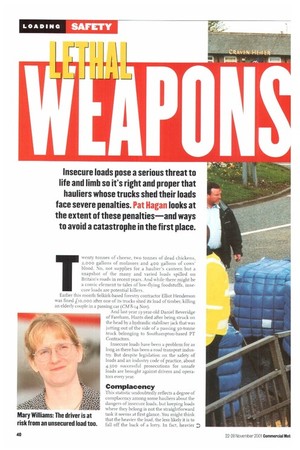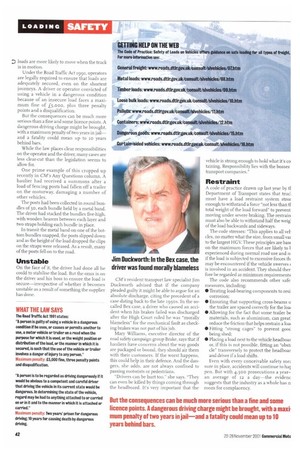Insecure loads pose a serious threat to life and limb
Page 40

Page 42

If you've noticed an error in this article please click here to report it so we can fix it.
so it's right and proper that hauliers whose trucks shed their loads face severe penalties. Pat Hagan looks at the extent of these penalties—and ways to avoid a catastrophe in the first place.
Twenty tonnes of cheese, two tonnes of dead chickens, 2.,000 gallons of molasses and 400 gallons of cows' blood. No, not supplies for a haulier's canteen but a snapshot of the many and varied loads spilled on Britain's roads in recent years. And while there might be a comic element to tales of low-flying foodstuffs, insecure loads are potential killers. Earlier this month Selkirk-based forestry contractor Elliot Henderson was fined iio,000 after one of its trucks shed its load of timber, killing an elderly couple in a passing car (CM8-14 Nov).
And last year 13-year-old Daniel Beveridge of Fareham, Hants died after being struck on the head by a hydraulic stabiliser jack that was jutting out of the side of a passing 30-tonne truck belonging to Southampton-based PT Contractors.
Insecure loads have been a problem for as long as there has been a road transport industry. But despite legislation on the safety of loads and an industry code of practice, about 4.500 successful prosecutions for unsafe loads are brought against drivers and operators every year.
Complacency
This statistic undoubtedly reflects a degree of complacency among some hauliers about the dangers of insecure loads, but keeping loads .. where they belong is not the straightforward
task it seems at first glance. You might think that the heavier the load, the less likely it is to
fall off the back of a lorry. In fact, heavier D
P loads are more likely to move when the truck is in motion.
Under the Road Traffic Act 1991, operators are legally required to ensure that loads are adequately secured, even on the shortest journeys. A driver or operator convicted of using a vehicle in a dangerous condition because of an insecure load faces a maximum fine of £5,000, plus three penalty points and a disqualification.
But the consequences can be much more serious than a fine and some licence points. A dangerous driving charge might be brought, with a maximum penalty of two years in jail— and a fatality could mean up to to years behind bars.
While the law places clear responsibilities on the operator and the driver, many cases are less clear-cut than the legislation seems to allow for.
One prime example of this cropped up recently in CM's Any Questions column. A haulier had received a summons after a load of fencing posts had fallen off a trailer on the motorway, damaging a number of other vehicles.
The posts had been collected in round bundles of 5o, each bundle held by a metal band. The driver had stacked the bundles five-high, with wooden bearers between each layer and two straps holding each bundle in place.
In transit the metal band on one of the bottom bundles snapped, the posts slipped down and as the height of the load dropped the clips on the straps were released. As a result, many of the posts fell on to the road.
Unstable
On the face of it, the driver had done all he could to stabilise the load. But the onus is on the driver and his boss to ensure the load is secure—irrespective of whether it becomes unstable as a result of something the supplier has done.
CM's resident transport law specialist Jim Duckworth advised that if the company pleaded guilty it might be able to argue for an absolute discharge, citing the precedent of a case dating back to the late 195os. In the socalled Bex case, a driver who caused an accident when his brakes failed was discharged after the High Court ruled he was "morally blameless" for the mechanical fault as checking brakes was not part of his job.
Mary Williams, executive director of the road safety campaign group Brake, says that if hauliers have concerns about the way goods are packaged or bound, they should air them with their customers. If the worst happens, this could help in their defence. And the dangers, she adds, are not always confined to passing motorists or pedestrians.
"Drivers can be hurt too," she says. "They can even be killed by things coming through the headboard. It's very important that the vehicle is strong enough to hold what it's co taming. Responsibility lies with the bosses transport companies."
Restraint
A code of practice drawn up last year by tl Department of Transport states that trud must have a load restraint system stria/ enough to withstand a force "not less than tl total weight of the load forward" to prevent moving under severe braking. The restrain must also be able to withstand half the weig of the load backwards and sideways.
The code stresses: "This applies to all veldes, no matter what the size, from small var to the largest HGV. These principles are bas( on the maximum forces that are likely to I experienced during normal road use and n, if the load is subjected to excessive forces th may be encountered if the vehide swerves is involved in an accident. They should ther fore be regarded as minimum requirements
The code also recommends other safe measures, including: • Treating load-bearing components to resi corrosion; • Ensuring that supporting cross-beams o the trailer are spaced correctly for the loa(
• Allowing for the fact that some trailer be materials, such as aluminium, can great. reduce the friction that helps restrain a loa( • Fitting "strong cages" to prevent gooC being shed;
• Placing a load next to the vehicle headboar or, if this is not possible. fitting an "obst: cle" transversely to protect the headboar and driver if a load shifts.
Even with every conceivable safety mei sure in place, accidents will continue to hai pen. But with 4,500 prosecutions a yearan average of 12 a day—the evidenc suggests that the industry as a whole has n room for complacency.




















































































































































